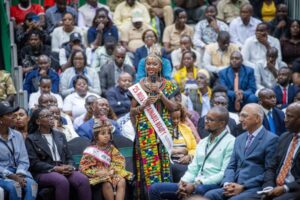CBK has said that the old Sh1,000 banknotes being withdrawn from circulation will be shredded and burned into ashes in Nairobi’s Kariobangi area.
According to Kenyan Bulletin insiders, once the old notes that are received at the CBK branches, they are transported in trucks to the headquarters where they are received, verified and stored in a deoxygenated room under the strict supervision of trustees and senior police officers attached to the bank.
The top officials will then set a date within a week when the collected notes will be cut into finer shreds and packed in sacks before being transported to Kariobangi North, near the market, where they will be burnt in the open under the watch of armed police officers.
“It is a rigorous process which leaves no room for someone to think of keeping some in his or her packets. Just like any other monies that are received at CBK, they are all under tight security,” a staff who is familiar with the process but not allowed to be quoted in the media told the Kenyan bulletin.
Speaking on the phone to the Star, CBK communications officer Wallace Kantai said CBK is mandated to control the money supply and confirmed the old notes are shredded.
“The notes would be shredded just like old notes that are destroyed and replaced with new ones,” Kantai said.
He, however, declined to comment on the percentage of monies in Sh1,000 notes exchanged so far, saying the regulator will announce on the last day.
Besides CBK head office on Nairobi’s Haile Selassie Avenue, members of the public who wish to change the old notes can also do so at its branches in Mombasa, Kisumu, Eldoret, Meru, Nakuru, and Nyeri.
Kenya is withdrawing the old Sh1,000 note with a new note in an exercise expected to be completed by October 1, which means the old notes will not be recognizable through an ATM, a vending machine, or another electronic reader after the deadline.
“By gazette notice no 4849 of May 31, 2019, all older Sh1,000 banknotes shall be withdrawn and will cease to be legal tender on October 1, 2019. All other denominations are unaffected and will continue to circulate alongside the new generation banknotes,” CBK Governor Patrick Njoroge said.
Under the Constitution, it was a requirement that CBK print new generation notes and coins that have no images of individuals.
“Notes and coins issued by the Central bank of Kenya may bear the images that depict or symbolize Kenya or an aspect of Kenya, but shall not bear the image of an individual,” Article 231(4) of the Constitution says.
Since Kenya attained independence in 1963, the currencies have had the images of the first three Presidents- Mzee Jomo Kenyatta, Daniel Moi and Mwai Kibaki. The new generation currencies embody diverse wild animals including the lion, the elephant, the rhino, the buffalo and the giraffe.
They also have the image of the iconic image of Kenyatta International Convention Centre and aspects of agriculture, education, green energy, and tourism.
However activist Okiya Omtata has filed a petition in court challenging the inclusion of the founding President saying it violates the Constitution.
He argues that putting a picture of Mzee Kenyatta’s full statue, which is erected in front of KICC on every note, CBK acted mischievously to sneak the portrait of the late President.
Financial analyst at Kenya Business Guide Titus Maina said Kenya has had a robust procedure of disposing of old notes.
“Definitely, there is are ways to dispose of the notes. It wouldn’t be the first time as a country to dispose of notes. We did this when we were phasing out the 10 and 20 shillings notes,” he said.
He said for CBK to deal with the headache of possible counterfeits, it should widen its sensitization campaigns in a bid to try teach Kenyans the security features in the new notes.
“The ongoing sensitization is absolutely not sufficient because of the form being used and also because we have already seen cases of counterfeits in places such as Embu,” he said.
“Most people can’t. People are still excited about the new notes and some are confused about the new ones. The excitement and confusion clouds their judgment in that they are not keen to check whether they are getting fake or genuine notes.” He added
He opined that in border towns, there have been concerns that there is a similarity between the new notes and Uganda’s, which has brought about a lot of confusion.
“The awareness campaign should have been a bit more rigorous and wide,” he said.
CBK has already unveiled the rules to guide the replacement of the notes, which account for 83 percent of the notes in circulation.
Those with less than Sh1 million and are non-account holders are required to just walk into any of the commercial bank outlets across the country or any of the CBK branches and change them.
Individuals with amounts up to Sh5 million are required to exchange the notes at their specific commercial banks while non-account holders having an excess of Sh5 million will have to get an endorsement of CBK.
“ Regulation 31 of the Proceeds of Crime and Anti-Money Laundering Regulations, 2013 — that banks obtain confirmations from customers on the nature of their business that generate large cash transactions — shall be adhered to,” Njoroge warned.
“These modalities are aimed at minimizing business disruptions, ensuring the security of cash transactions, and safeguarding the integrity of the financial sector. The intention is to make the process as straight forward as possible, particularly for smaller amounts.” Njoroge Added
















